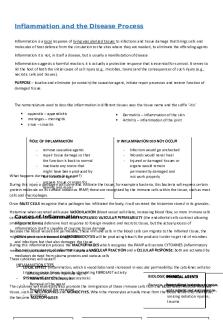Addisonian Crisis - ATI template on disease process PDF

| Title | Addisonian Crisis - ATI template on disease process |
|---|---|
| Course | Med surg 2 |
| Institution | Northwestern College |
| Pages | 1 |
| File Size | 90.9 KB |
| File Type | |
| Total Downloads | 60 |
| Total Views | 165 |
Summary
ATI template on disease process...
Description
ACTIVE LEARNING TEMPLATE:
System Disorder
ST UDENT NAME _____________________________________
Addisonian Crisis DISORDER/DISEASE PROCESS __________________________________________________________
Alterations in Health (Diagnosis) Addisonian crisis is a life-threatening condition in which the body's demand for cortisol and aldosterone exceeds its supply.
Pathophysiology Related to Client Problem It often happens as a result of a traumatic event such as surgery, trauma, or a serious infection, particularly if the adrenal hormone production is already low.
REVIEW MODULE CHAPTER ___________
Health Promotion and Disease Prevention Patients with primary adrenal hypofunction or Addison's disease must take cortisol replacement on a daily basis. During periods of stress, increase replacement hormone dosages.
ASSESSMENT
SAFETY CONSIDERATIONS
Risk Factors
Expected Findings
• Tuberculosis • Metastatic cancer • HIV-III (AIDS) • Hemorrhage • Gram-negative sepsis • Adrenalectomy • Abdominal radiation therapy • Drugs (mitotane) and contaminants • Adrenalectomy • Abdominal radiation therapy
Laboratory Tests
The symptoms of lethargy, exhaustion, and muscle weakness are common. salt cravings are common in hypofunctioning people.
Diagnostic Procedures
The Adrenal Gland Assessment: Low serum sodium and salivary cortisol levels, low fasting blood glucose, elevated potassium, and high blood urea nitrogen (BUN) levels, Eosinophil count and ACTH levels are both elevated in primary disease. During provocation tests, plasma cortisol levels don't rise.
CT and MRI are extremely useful. Adrenal gland atrophy can be seen on CT and MRI scans, but not the cause.
PATIENT-CENTERED CARE
Nursing Care The critical care nurse role includes: inserting a nasogastric tube to treat vomiting if aspiration is a concern due to a decreased level of consciousness. providing ongoing reorientation for confused individuals as well as ensuring a safe environment through one-on-one sitters for agitated individuals. Reduce physiologic and emotional stressors, as these will raise the risk of
Therapeutic Procedures - patient cortisol and aldosteron levels stabilized. - patient informed of lifelong therapy
ACTIVE LEARNING TEMPLATES
Neuromuscular Symptoms • Muscle weakness • Fatigue • Joint and/or muscle pain Gastrointestinal Symptoms • Anorexia • Nausea, vomiting • Abdominal pain • Constipation or diarrhea • Weight loss • Salt craving Skin Symptoms • Vitiligo or • Hyperpigmentation Cardiovascular Symptoms • Anemia • Hypotension • Hyponatremia • Hyperkalemia • Hypercalcemia
Complications Medications Start a rapid infusion of normal saline or dextrose in normal saline at 5%. • Higher doses of hydrocortisone sodium or dexamethasone are given as an IV bolus at first. • Continue administering hydrocortisone sodium via IV infusion for the next 8 hours. • Start an H2 histamine blocker (e.g., cim) and give an additional dose of hydrocortisone IM concomitantly with hydration every 12 hours.
Client Education Patients can appear lethargic, depressed, confused, or even psychotic, depending on the severity of the imbalance. Examine the patient's sense of person, place, and time. Families can report the patient's mood swings and forgetfulness.
Interprofessional Care Addisonian crisis is is a medical emergency that must be treated quickly. Death is the result of ineffective management.
Extremely low blood pressure Pain in the stomach, back, and legs that comes on suddenly Shock from Syncope Severe nausea, diarrhea, and headache Hyponatremia Hyperkalemia Hypoglycemia
THERAPEUTIC PROCEDURE
A11...
Similar Free PDFs

PEDS ATI - ATI Template
- 1 Pages

ATI Urinary#4 - ATI Template
- 1 Pages

ATI Renal#3 - ATI Template
- 1 Pages

Essay on Crisis Intervention
- 9 Pages

Process Costing Template
- 4 Pages
Popular Institutions
- Tinajero National High School - Annex
- Politeknik Caltex Riau
- Yokohama City University
- SGT University
- University of Al-Qadisiyah
- Divine Word College of Vigan
- Techniek College Rotterdam
- Universidade de Santiago
- Universiti Teknologi MARA Cawangan Johor Kampus Pasir Gudang
- Poltekkes Kemenkes Yogyakarta
- Baguio City National High School
- Colegio san marcos
- preparatoria uno
- Centro de Bachillerato Tecnológico Industrial y de Servicios No. 107
- Dalian Maritime University
- Quang Trung Secondary School
- Colegio Tecnológico en Informática
- Corporación Regional de Educación Superior
- Grupo CEDVA
- Dar Al Uloom University
- Centro de Estudios Preuniversitarios de la Universidad Nacional de Ingeniería
- 上智大学
- Aakash International School, Nuna Majara
- San Felipe Neri Catholic School
- Kang Chiao International School - New Taipei City
- Misamis Occidental National High School
- Institución Educativa Escuela Normal Juan Ladrilleros
- Kolehiyo ng Pantukan
- Batanes State College
- Instituto Continental
- Sekolah Menengah Kejuruan Kesehatan Kaltara (Tarakan)
- Colegio de La Inmaculada Concepcion - Cebu










